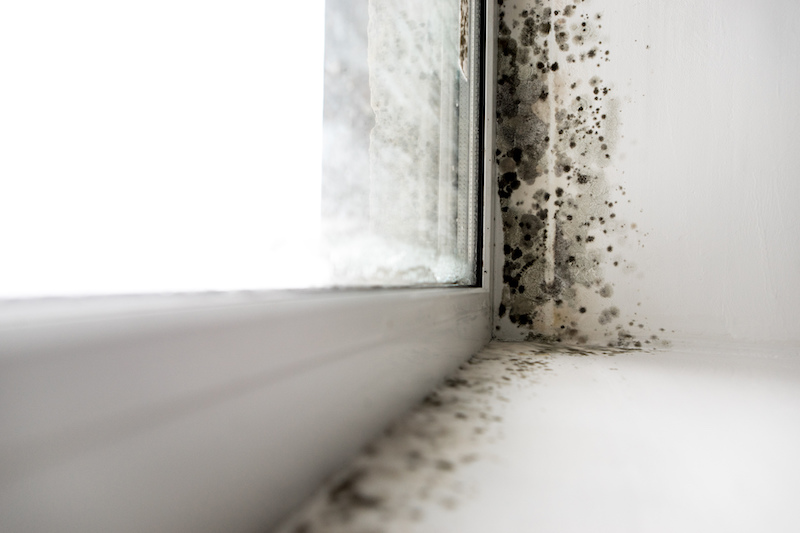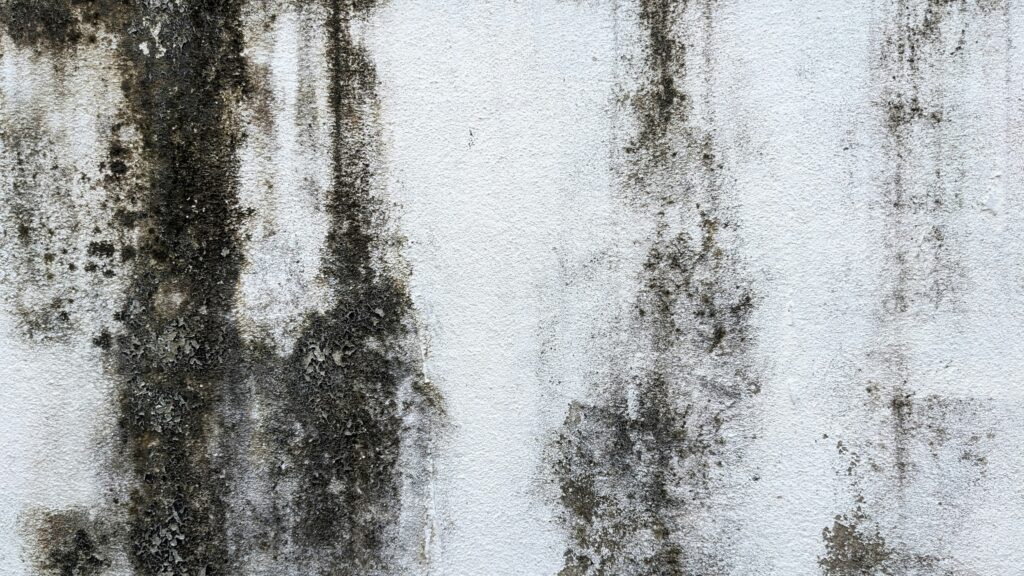Knowing how to test for mold in a house with people susceptible to allergies, respiratory conditions, and other health concerns might mean the difference between continued good health and poor quality of life. Read on to learn how to check for mold in your house, how to test for mold to keep your property as mold- and mildew-free as possible.

What does mold look like?
As they say, know thy enemy. If you get an idea of what the common types of mold are and what they look like, mold detection it’s guaranteed to be a lot easier to deal with. Mold comes in many forms, and some can be more harmful than others. Here are four of the most common types of mold:
- Black Mold (stachybotrys chartarum) – This allergenic, black pepper-like microorganism is most prevalent in wood, wallpaper, and leaky ceiling surfaces. It has a strong musty odor, often hidden behind walls.
- Aspergillus – A very common fungal spore that causes aspergillosis, a respiratory infection. This fungus may start white before turning green or gray with a powdery texture. Usually grows on walls and fabrics.
- Cladosporium – With at least 500 species, identifying this allergenic microorganism can be challenging. Their appearance is usually brownish or greenish with a velvety-like texture. It often grows in circular patches on carpets, upholstery, and under sinks.
- Penicillium – We owe a lot to this mold, which shares its name with the antibiotic. It has a plush texture that’s blue-green in color and usually grows on aged fruit and veg, but also water water-damaged structures. Spreads quickly and it’ll cause a flare-up in respiratory problems like asthma.
How do you detect mold in your house?
Although most homeowners leave mold detection and removal to professionals, they recognize the importance of testing for the presence of mold and mildew. That way, it’s easier to tell if the mold requires a professional to successfully remove it.
It is important to notice that the US Centers for Disease Control and Prevention doesn’t recommend mold testing or sampling, they suggest immediate removal of any type of mold that occurs. Here’s how to test for mold in your home.
1. Make a home mold test kit
To make a mold test kit at home, you will need to do a diluted bleach test on the suspected mold. Combine 16 tablespoons of water and a tablespoon of bleach to make a home mold test kit. Get a cotton swab, dip it into the bleach-water solution, and dab it on suspected mold-infested sections.
Assume the presence of mold if the area changes color immediately after dabbing it with diluted bleach. Alternatively, the area returns to its original color (black or greenish-black) after blotting. This method isn’t as sophisticated as professional mold testing. However, it gives you a heads-up whether you have a mold infestation in your home.
2. Buy a mold detection test
If unsure about the results of the DIY home mold test kit, purchase a black mold test package. Mold and mildew testing packages come in two forms: test-only and test-with-species-identification. The former is cheaper and only serves to confirm mold presence in the home. Testing kits with species identification are suitable for those curious about the specific mold.
When mold isn’t obvious, testing can be useful to determine if it is present. However, a faster means of gauging if mold is present is to simply listen to the body. Feeling unwell? Check out the 10 most common symptoms of black mold.
3. Follow the mold testing kit instructions
Mold detection kits include step-by-step instructions on growing a suitable medium for promoting mold growth. We recommend reading this to get accurate results. Most testing packages come with Petri dishes and other tools for collecting and managing the sample.
The specimen collection depends on what part of the house you want to test for mold. Leave the Petri dish for as long as instructed, then cover it to grow the mold. This method is perfect for checking mold in ventilation systems and similar technologies that aren’t easily accessed, or if you’re unsure about mold being present at all.
4. Assess the test for mold infestation
The Federal Emergency Management Agency (FEMA) says mold and mildew need 24 to 48 hours to develop after moisture exposure. Check the Petri dish after 48 hours or as instructed for the telltale signs of mold.
Assess the sample again after another 24 hours if you didn’t see mold signs in the first 48 hours. If the instant mold test produces negative results, it’s safe to say there’s no mold.
A mold test kit can help determine if your home has a mold problem, and how severe it is. They don’t replace professional lab analysis, but they’re useful for initial mold detection.
What are the Most Common Places to Find Mold in a Home?
The US Centers for Disease Control and Prevention says mold grows in high-moisture areas, including plumbing, around windows, and on roofs. Mold can also populate wallpapers, upholstery, paints, drywall, fabrics, and insulation. These are the most common places to find mold in a home:

- Test for mold in walls – Look for telltale signs of mold on walls. You can check wall surfaces with a screwdriver, wooden walls tend to soften, rot, and crumble with mold infestation. If it does, it needs to be completely replaced.
- Test for mold in the air – Mold is everywhere. Leave a mold testing kit Petri dish open for an hour to capture as many mold organisms as possible for culture.
- Test for mold in air vents – Air vents are warm and humid, a favorable environment for mold and other microorganisms.
- Test for mold in carpet – Poor or low-quality carpets are more susceptible to mold growth than high-quality options, especially when exposed to too much moisture. A mold detector should help identify mold presence on carpet if it’s not obvious just from looking.
- Test for mold in basement – Condensation and leaks are prevalent in basements, creating a hospitable environment for mold.
- Test for mold in attic – Poor ventilation and humidity make attics prone to mold growth.
Looking for the most effective ways to prevent mold? Discover 5 essential ways to prevent mold from occurring now.
FAQ
How can I tell if there is mold in my home?
Your eyes and nose are the most important mold detector tools at your disposal. Mold produces a characteristic musty scent as the first sign of a moldy problem. You can also see slimy and fuzzy discolorations on surfaces. These “unusual” patches grow over time.
Can I test for mold myself, or do I need to hire a professional?
Yes, you can test for mold yourself. However, a commercially available mold detector might produce inaccurate results compared to professional testing and lab work, which are necessary for mold in workplaces, shops, and restaurants.
What should I do if mold is found in my home?
The CDC recommends removing the mold with a bleach solution comprising a gallon of water and a cup of ordinary bleach. A soapy solution and other cleaning products can also work.
Do air purifiers help with mold?
Yes, air purifiers help with removing mold by capturing spores floating in the air, preventing mold reproduction and spread.
Conclusion
Learning how to test for mold is as easy as using your senses to detect the telltale signs of a mold infestation. If you spot it, you can always test it with a commercially available kit to confirm. Otherwise, skip straight to mold removal and help protect household inhabitants from mold-related health problems.
If you own or manage a property, such as a vacation home, rental unit, or storage space, monitoring for mold without frequent in-person checks can be a challenge. Fortunately, you can use an indoor security camera to keep an eye on vulnerable spots for visible mold growth, leaks, or condensation buildup.
Allowing you to act before mold spreads can help prevent costly property damage. Check out our free app AlfredCamera, a simple home security system to watch over your property.
